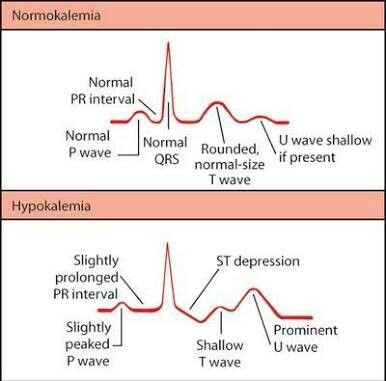Inverted T Wave On Ekg

Causes of inverted t waves.
Inverted t wave on ekg. If the readings show different characteristics then you have inverted t waves. Wellens syndrome is a pattern of inverted or biphasic t waves in v2 3 in patients presenting with following ischaemic sounding chest pain that is highly specific for critical stenosis of the left anterior descending artery. The normal t wave is usually in the same direction as the qrs except in the right precordial leads see v2 below. For instance a single inverted t wave in either lead iii or avf can be a normal variant.
In most leads of ecg t wave normally is upright. The t wave should be concordant with the qrs complex meaning that a net positive qrs complex should be followed by a positive t wave and vice versa figure 17. The t wave is the ecg manifestation of ventricular repolarization of the cardiac electrical cycle. The t wave is the most labile wave in the ecg.
And variable in leads iii avl avf v1 and v2. T wave changes including low amplitude t waves and abnormally inverted t waves may be the result of many cardiac and non cardiac conditions. During the ventricular re polarization t wave shows normal upright. Thus t wave inversions in leads v1 and v2 may be fully normal.
However only t wave abnormality should not be interpreted alone for specific diagnosis of a condition. T wave abnormalities introduction. In normal ecg readings the t wave should be upward. Inverted t wave is considered abnormal if inversion is deeper than 1 0 mm.
There are two patterns of t wave abnormality in wellens syndrome. Inverted t waves are always noted in the avr and v1 leads. A negative t wave is also called an inverted t wave. Type a biphasic t waves with the initial deflection positive and the terminal.
Otherwise there is discordance opposite directions of qrs and t which might be due to pathology. Inverted t waves mean on an ecg that you should go for further testing. Inverted t waves associated with cardiac signs and symptoms chest pain and cardiac murmur are highly suggestive of myocardial ischaemia. The t wave should be concordant with the qrs complex meaning that a net positive qrs complex should be followed by a positive t wave and vice versa figure 17.
Otherwise there is discordance opposite directions of qrs and t which might be due to pathology. In general an inverted t wave in a single lead in one anatomic segment ie inferior lateral or anterior is unlikely to represent acute pathology. The t wave is normally upright in leads i ii and v3 to v6. On ecg t wave is seen as a small wave after qrs complex.
The interpretation of the ecg in the context of the individual patient presentation is mandatory. Inverted in lead avr. It is usually an upward curve that is followed by a rapid dip. An abnormal t wave is inverted in many sections of ecg.
















































